Pavlova
This post may include affiliate links. Thank you for your support.
Learn how to make the perfect pavlova with this simple recipe. It’s crisp on the outside and has a soft, fluffy marshmallow center on the inside. Top it with coconut whip cream and fresh fruit for an elegant dessert that’s sure to impress guests.
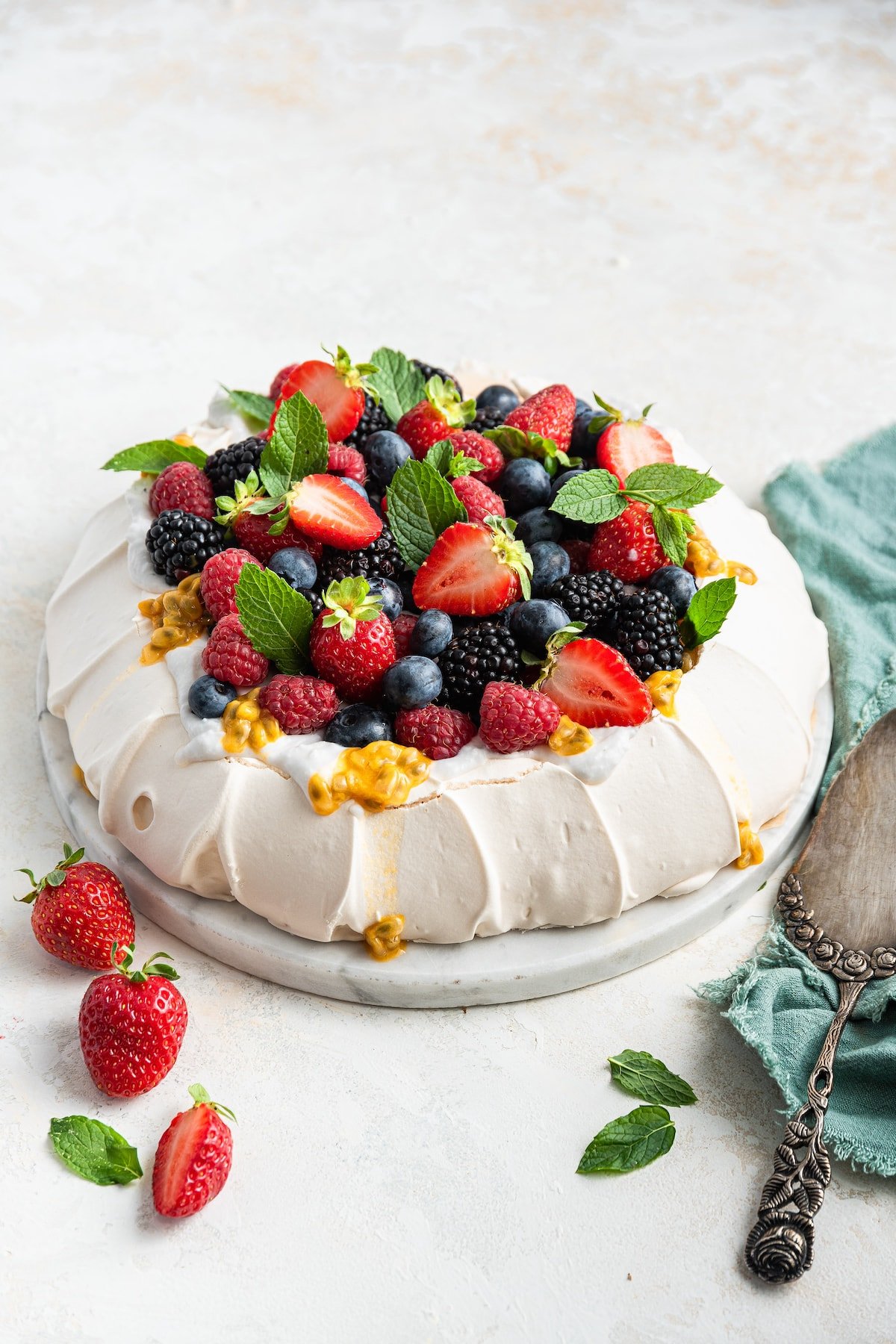
This delicate dessert has always intrigued me. I’ve tried it a few times, but I had never made one myself until now. Inspired by how much I enjoyed it every time, I decided to give it a shot at home.
A pavlova is a type of meringue made from whipped egg whites. It has a crisp and delicate exterior with a soft, marshmallow-like interior. It’s traditionally topped with whipped cream and fresh fruit, making it both beautiful and delicious.
If you’re searching for a show-stopping dessert for a special occasion, this is it. It might seem intimidating at first, but it’s actually quite simple to make. The hardest part is waiting for it to bake and cool, but the results are absolutely worth it!
Table of Contents
Why You’ll Love This Recipe
- Simple ingredients – You only need 5 basic ingredients to make the base of this pavlova. No fancy techniques or hard-to-find ingredients required.
- Naturally gluten free – This dessert is naturally gluten free, making it a great option for anyone with dietary restrictions. And trust me, no one will miss the flour!
- Irresistible texture – The combo of a crisp, crunchy exterior paired with the soft, marshmallow-like center is truly magical. It’s a dessert that feels light but satisfies every sweet craving.
- Customizable – Top it with your favorite seasonal fruits, whipped coconut cream, or even a drizzle of chocolate. The options are endless, so you can make it your own!
Pavlova Ingredients
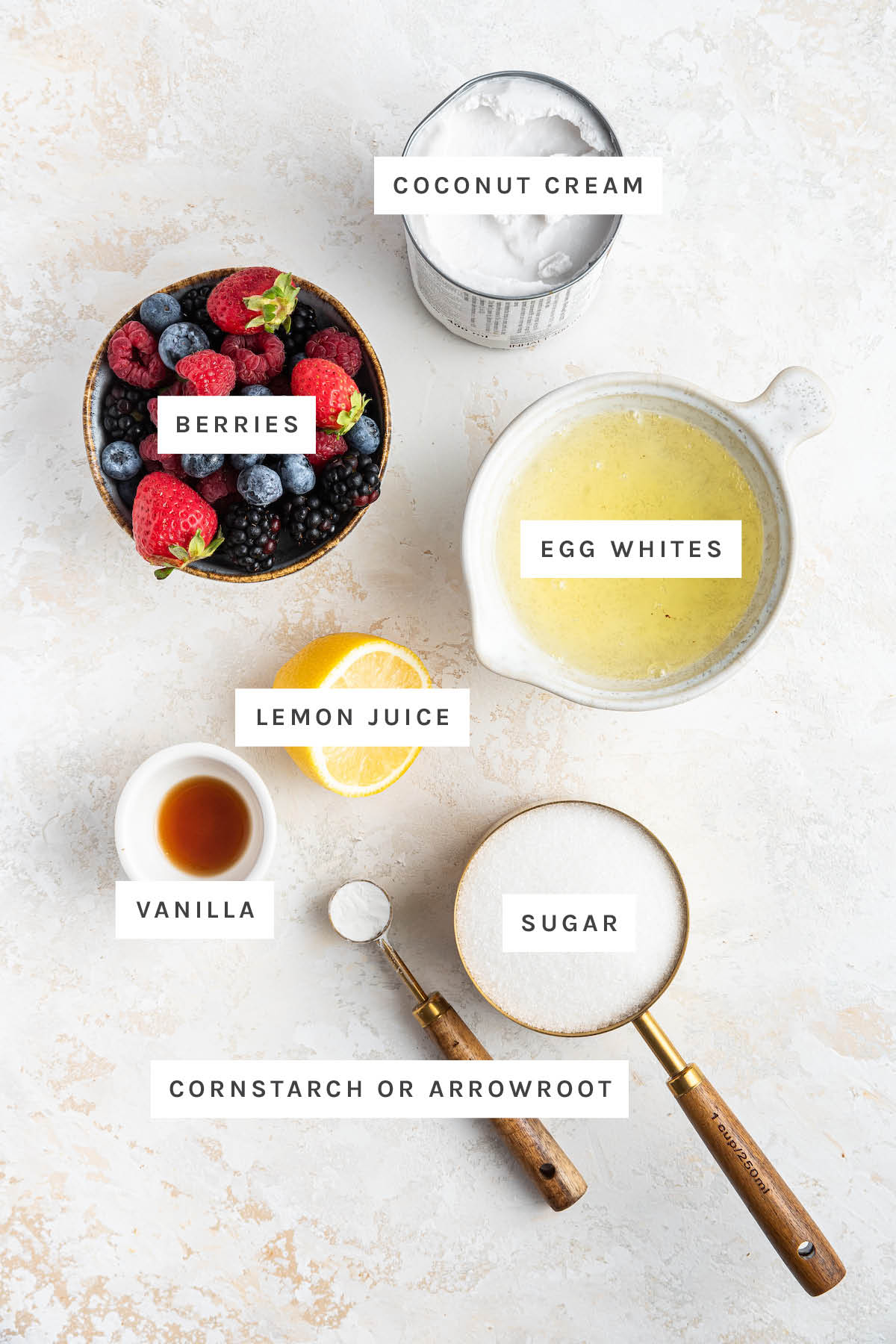
- egg whites – the pavlova base and what gives it its marshmallowy texture.
- granulated sugar – the sweetener in this recipe. The sugar also helps to stabilize the egg whites, resulting in a fluffy and stable meringue.
- lemon juice – a key ingredient, as it helps to stabilize the egg whites and keep them from collapsing. It also balances out the sweetness of the meringue and the fruit.
- vanilla extract – a flavor enhancer.
- cornstarch – helps to create a light, fluffy center and crisp exterior.
- coconut cream – used for a whipped cream topping.
- fresh berries – for topping! Blackberries, blueberries, raspberries and strawberries are all good options!
- fresh mint – optional, but mint is a nice refreshing and light topping that brings a bright flavor to this dessert.
Substitutions
- Egg Whites: These are the heart of any pavlova and what give it that marshmallowy texture. If you’re experimenting, aquafaba (the liquid from canned chickpeas) might work, but I haven’t tried it myself, so let me know how it turns out!
- Granulated Sugar: Caster sugar (also called superfine sugar) is a great swap since it dissolves easily, giving you that silky smooth meringue. Avoid liquid sweeteners like honey or maple syrup—they’ll mess with the structure.
- Lemon Juice: No lemons? No problem. White vinegar or apple cider vinegar works perfectly here. They stabilize the egg whites just as well and keep everything fluffy.
- Cornstarch: Arrowroot powder or tapioca starch will do the trick if you’re out of cornstarch. They help create that signature crisp shell and soft center.
- Coconut Cream: If you’re not dairy-free, heavy whipping cream is a perfect alternative. For a lighter option, try Greek yogurt whipped with a drizzle of honey, it’s so good!
How to Make
This easy pavlova recipe is simple to make and so impressive! With just a few ingredients, you’ll create a dessert that’s crisp outside, soft inside, and perfect for any occasion.
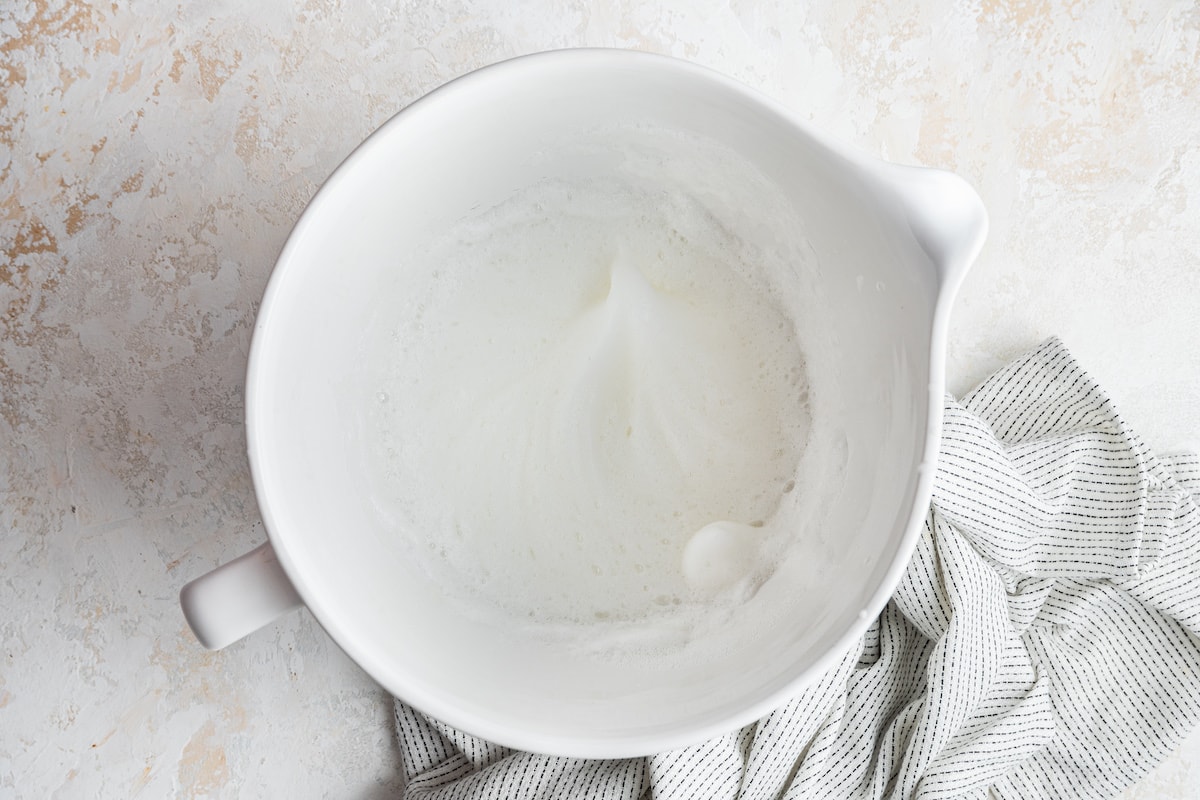
Step 1: Preheat your oven to 200°F and line a baking tray with parchment paper. In a medium mixing bowl, beat the egg whites on medium speed with a hand mixer until soft peaks form (about 2 minutes).
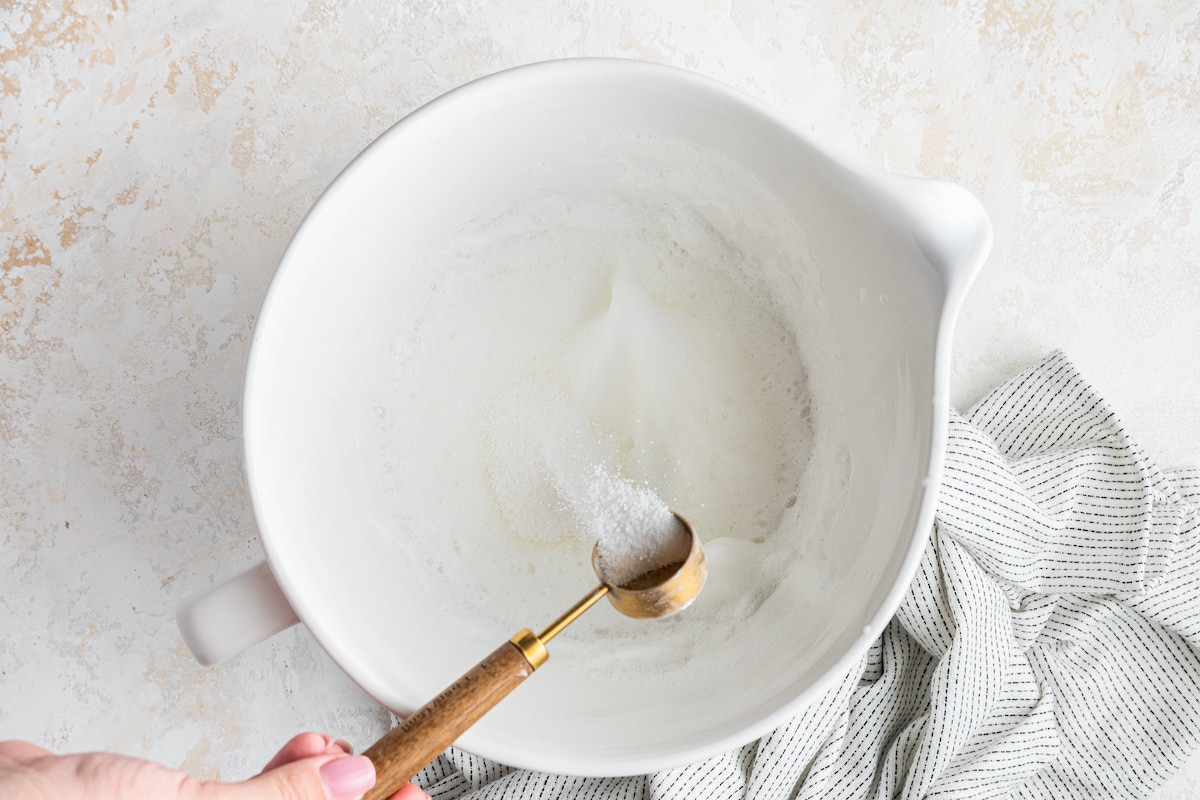
Step 2: Gradually add sugar while mixing, then increase the speed to high and beat for 3-5 minutes until stiff peaks form.
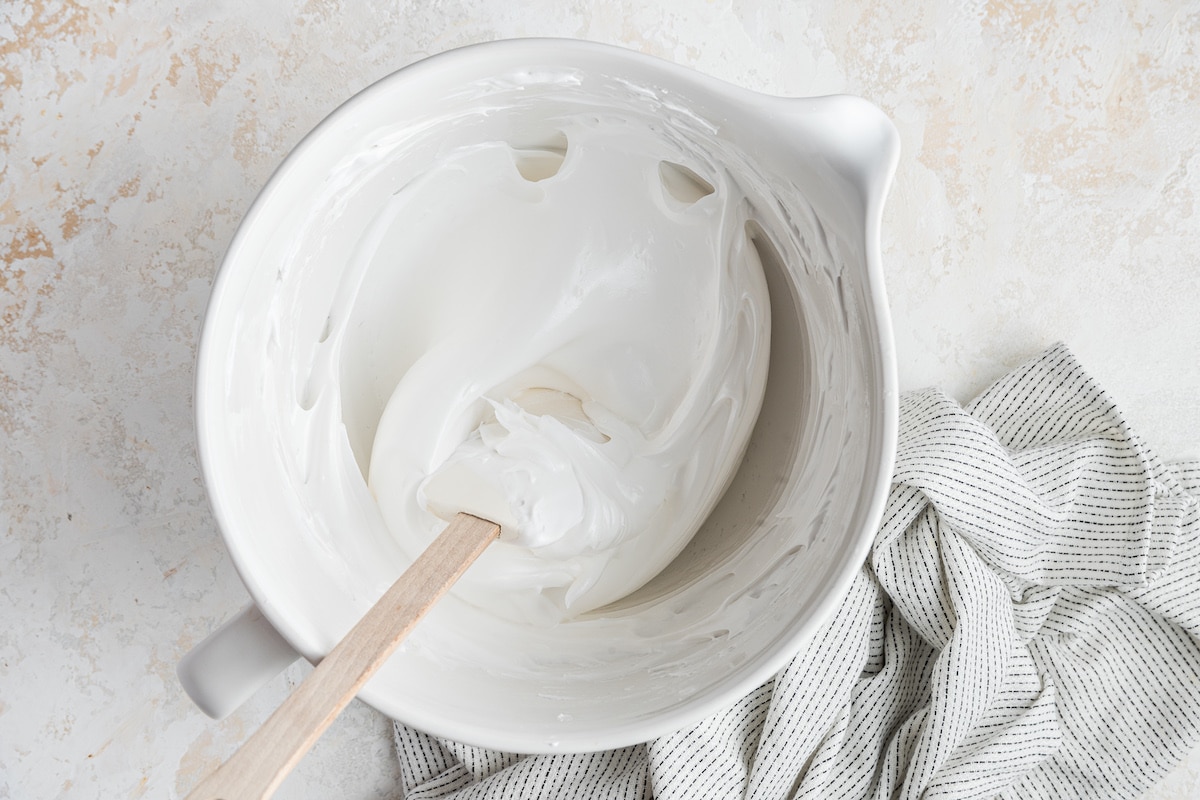
Step 3: Add lemon juice, vanilla extract, and cornstarch, and gently fold with a spatula.
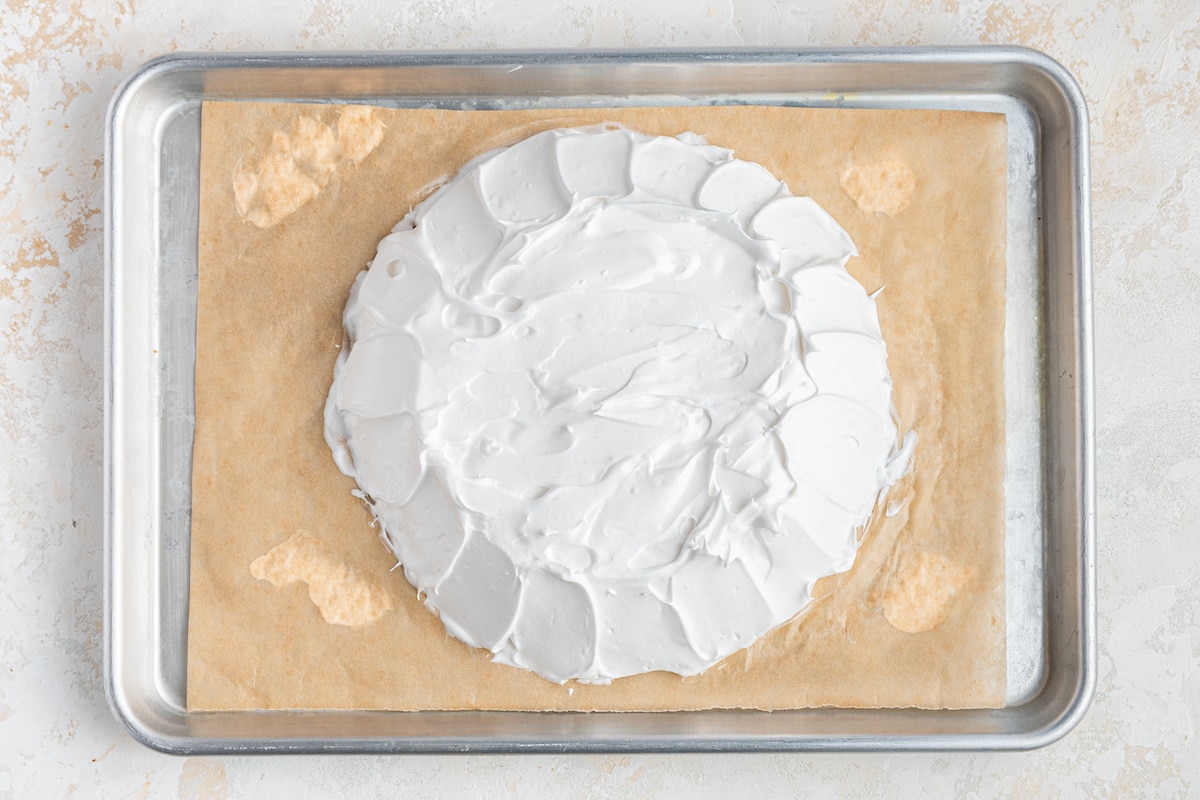
Step 4: Spoon the mixture onto the prepared baking tray, shaping it into an 8-9 inch circle. Flatten the top and smooth the sides for an even shape.

Step 5: Bake for 90 minutes without opening the oven door. Turn off the oven and let the pavlova cool completely inside for about 1 hour.
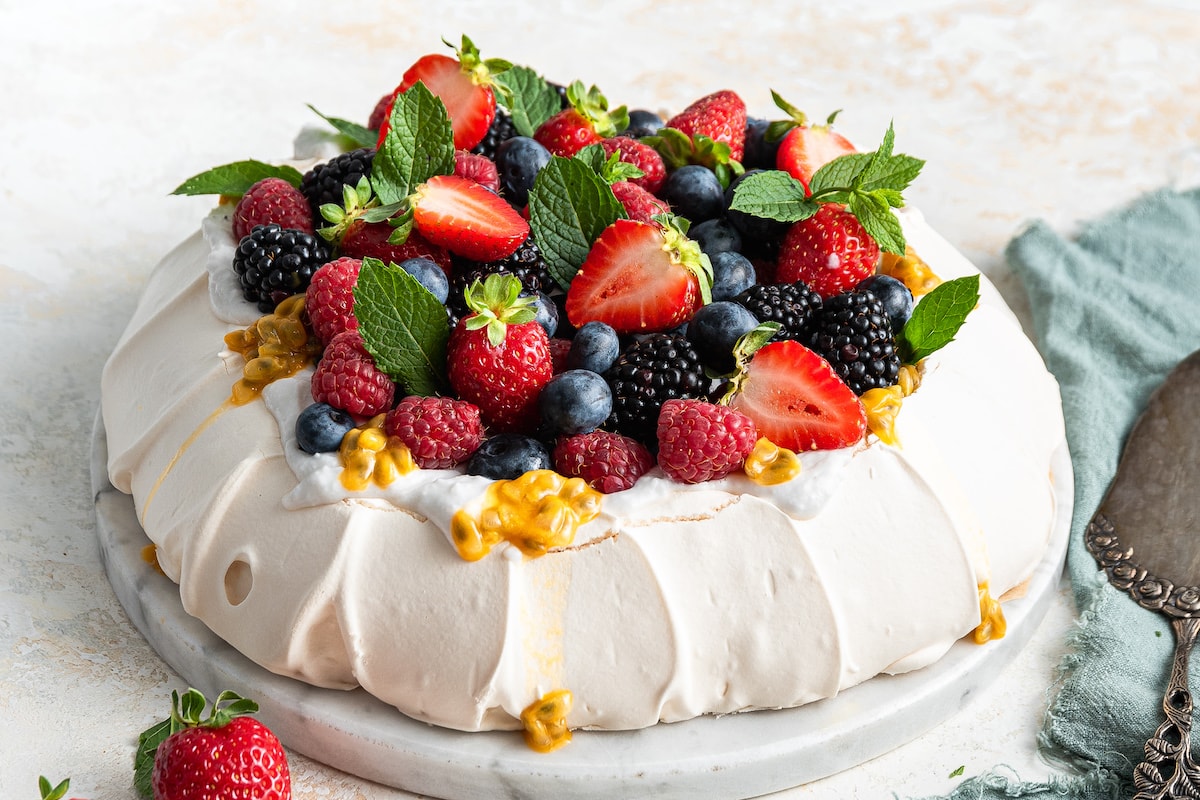
Step 6: Once cool, top with coconut whip cream, fresh berries, and mint leaves. Slice and serve immediately!
Tips For Success
- Make sure all utensils are dry: Any utensils that are used to mix or shape the pavlova before baking should be completely dry. Even the smallest amount of moisture and you may end up with a runny inside.
- Make sure the sugar is dissolved: Undissolved sugar can lead to cracks within the pavlova by creating unwanted air bubbles. This is why it’s important to slowly add the sugar to the egg whites, while also turning the hand mixer to a high speed. This will help make sure the sugar is completely dissolved before baking.
- Avoid overbeating egg whites: If your pavlova comes out grainy you likely overbeat your eggs. If this happens, simply start over again with fresh egg whites. Keep your hand mixer at a medium speed when beating the eggs and beat until thick and glossy.
- Don’t open the oven door: It’s tempting to check on the precious pavlova in the oven, but try to avoid opening the door. When you expose the pavlova to outside temperature too soon, it may crack, or even collapse on itself.
- Avoid baking on humid days: Temperature plays a key role in baking the perfect pavlova. If you are in a humid environment, you may find it difficult for the pavlova to keep its shape.
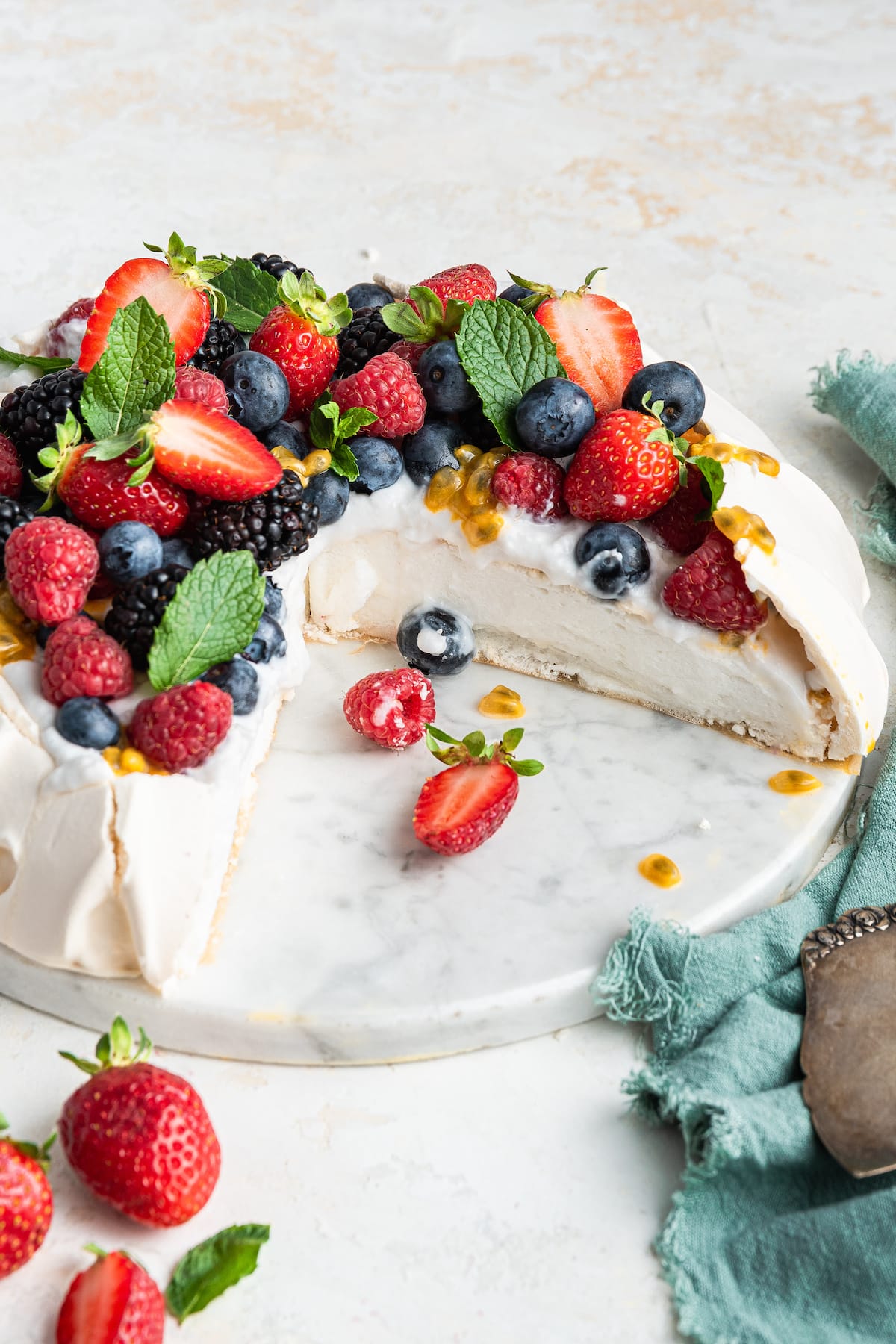
Pavlova Toppings
There are endless possibilities when it comes to the toppings for this dessert. You can add your favorites to customize to your liking or enjoy it as is. Here are some ideas that would work well:
- Fresh fruit: Blackberries, strawberries, blueberries, citrus fruits, peaches, mangos and sliced bananas are all great options.
- Flavored syrups or sauces: A drizzle of maple syrup or honey would make for an excellent topping. I bet this date caramel sauce would be delicious. You could also try lemon curd!
- Chocolate: Whether it be melted chocolate drizzled on, or a crushed bar of chocolate sprinkled on, you can’t go wrong with adding chocolate!
- Nuts: Add your favorite nuts for a slight crunch. Toasted almonds, walnuts, or pecans are some great options. For more of a decadent addition you could add candied walnuts or candied pecans.
- Dried fruit: Dried berries like goji berries would taste delicious with this pavlova.
- Whipped cream: Coconut whipped cream is a great option, but you could go with the classic whipped cream as well.
- Ice cream: A cold scoop of vanilla ice cream to top off this pavlova is a wonderful idea.
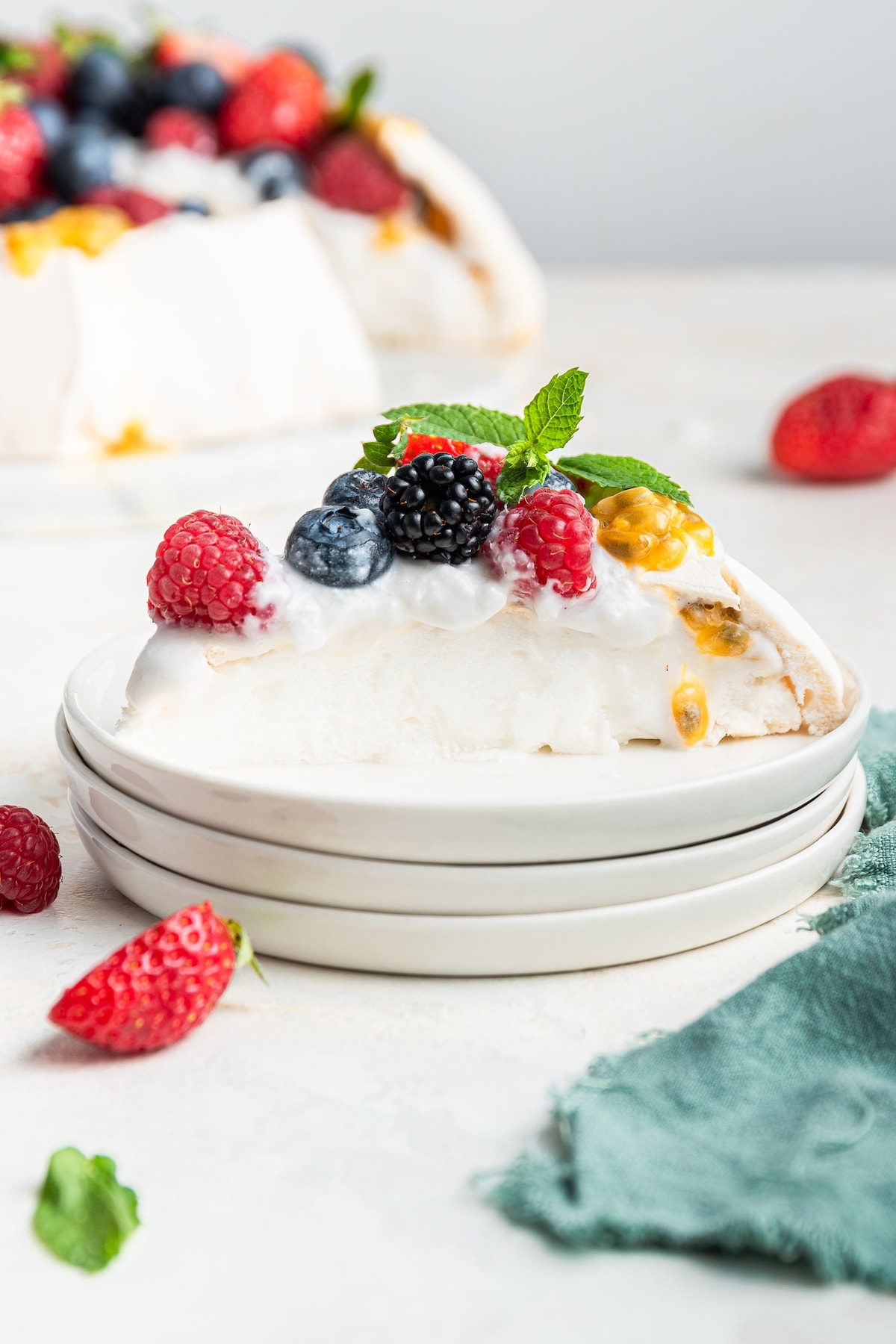
How to Store
Store any leftovers in an airtight sealed container at room temperature for 1-2 days. Try to keep it in a dry storage place as this sweet treat is incredibly sensitive to temperatures. I don’t recommend storing the pavlova in the fridge as it will become soggy.
Frequently Asked Questions
No, unfortunately, you cannot freeze pavlova. The structure will lose any crispiness once unthawed from the freezer.
Pavlova is a meringue-based dessert named after the Russian ballerina Anna Pavlova, but its origins can be traced back to the New Zealand and Australian regions where Anna Pavlova toured during the 1920s. Classic pavlova is made by combining egg whites, sugar, corn starch and some sort of acid which is then cooked in a slow oven until crisp on the outside and soft and fluffy on the inside. It can be served with a wide variety of toppings, but it’s commonly topped with whipped cream and fresh berries.
A pavlova is done baking when the outside is crisp and firm to the touch and the inside is soft and fluffy. The pavlova should also be a light golden brown in color and should be easy to lift off the baking sheet. If you end up over-baking, the pavlova will likely collapse on itself. This can also happen if you expose it to cool air too quickly, which is why we leave it in the oven to cool down for an hour.
More Dessert Recipes
- Vegan Chocolate Tart
- Vegan Blueberry Cheesecake Bars
- Healthy Vanilla Cupcakes
- Creamy Avocado Lime Tart
- Healthy Greek Yogurt Berry Tart
- Flourless Chocolate Cake
- Easy Berry Cake
Be sure to check out all of the dessert recipes on EBF!
If you enjoyed this recipe, please consider leaving a ⭐ star rating and let me know how it went in the 📝 comments below.
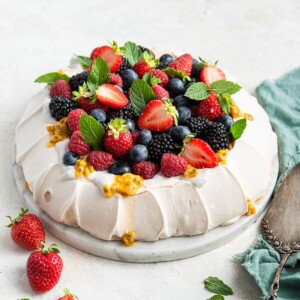
Pavlova
Ingredients
- 4 large egg whites, at room temperature
- 1 cup granulated sugar
- 1 teaspoon lemon juice, or white vinegar
- ½ teaspoon vanilla extract
- 1 teaspoon cornstarch or arrowroot flour
- 1 15 oz can coconut cream, whipped, for topping
- Fresh berries, for topping
- Mint leaves, for garnish
Instructions
- Preheat oven to 200ºF and line a baking sheet with parchment paper.
- Using a hand mixer beat egg whites on medium speed in a medium mixing bowl until soft peaks form, about 2 minutes.
- With mixer on, gradually add sugar, turning speed up to high. Beat for 3-5 minutes until stiff peaks form.
- Add lemon juice, vanilla and cornstarch or arrowroot powder and gently fold in with a spatula.
- Pour mixture onto parchment paper and shape into roughly an 8 or 9-inch wide circle, flattening the top and smoothing the sides.
- Bake for about 90 minutes, avoiding opening the oven door as much as possible.
- Turn off oven and allow pavlova to cool completely in the oven, about 1 hour.
- Once cool, top with coconut whip cream, fresh berries and mint leaves. Slice and serve immediately!
Notes
- Storage: Store any leftovers in an airtight sealed container at room temperature for 1-2 days. Try to keep it in a dry storage place as this sweet treat is incredibly sensitive to temperatures. I don’t recommend storing the pavlova in the fridge as it will become soggy.
Nutrition
Nutrition information is automatically calculated, so should only be used as an approximation.
Like This Recipe? Rate & Comment Below!
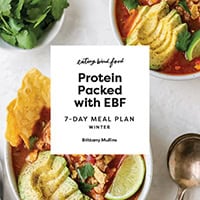
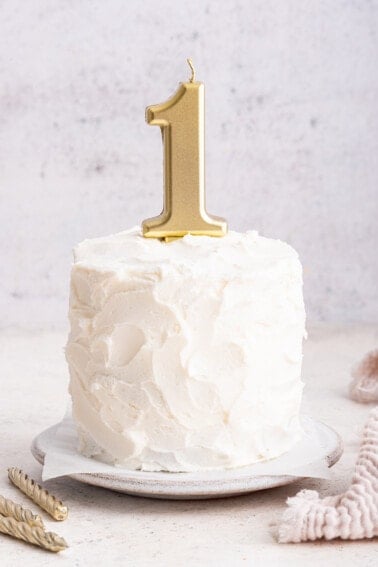
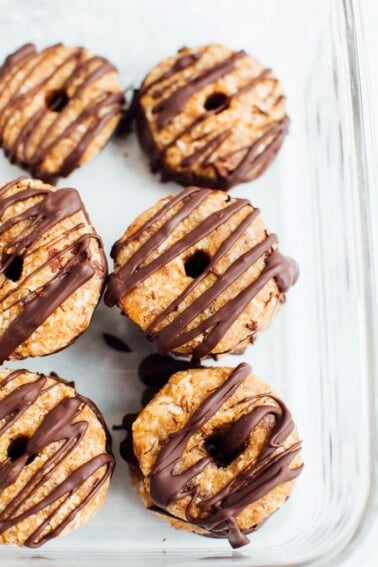
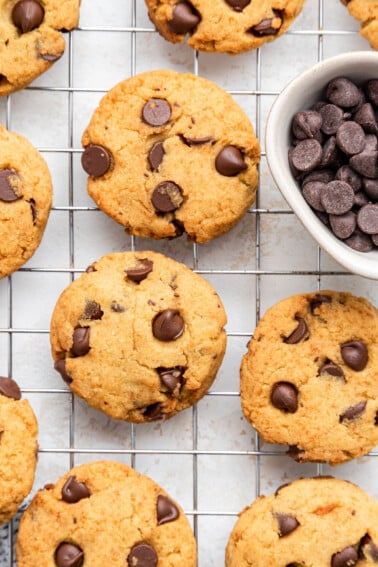
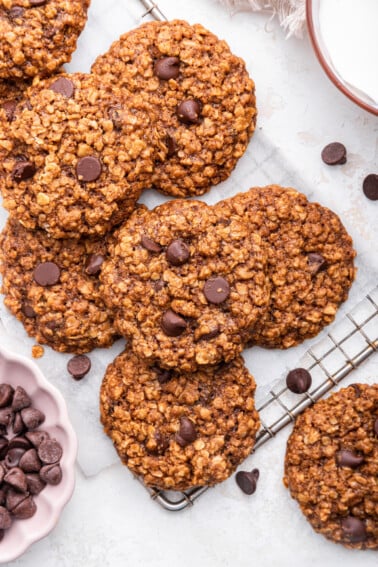







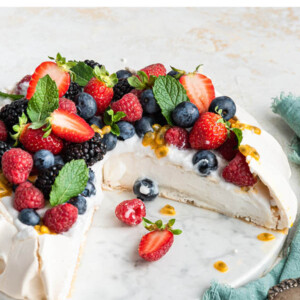
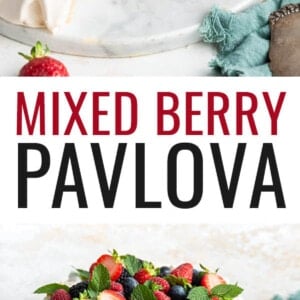
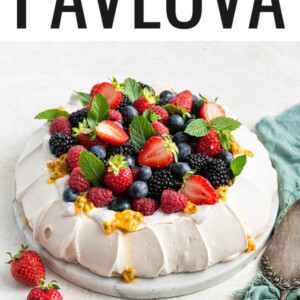
Is there any way to do a pavlova with a different sugar? Coconut sugar or honey or maple sugar?
Hi Kristi – I haven’t tested this recipe with another sugar but coconut sugar might work. The pavlova will be darker with the coconut sugar. If you give it a try, let me know how it turns out!
Can you use a different sugar?
Hi Nancy – I would recommend cane or granulated sugar. I would not suggest making any substitutions in this recipe. I hope you enjoy!